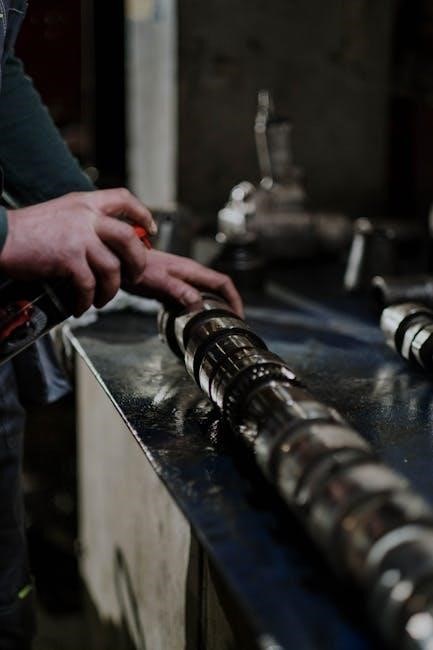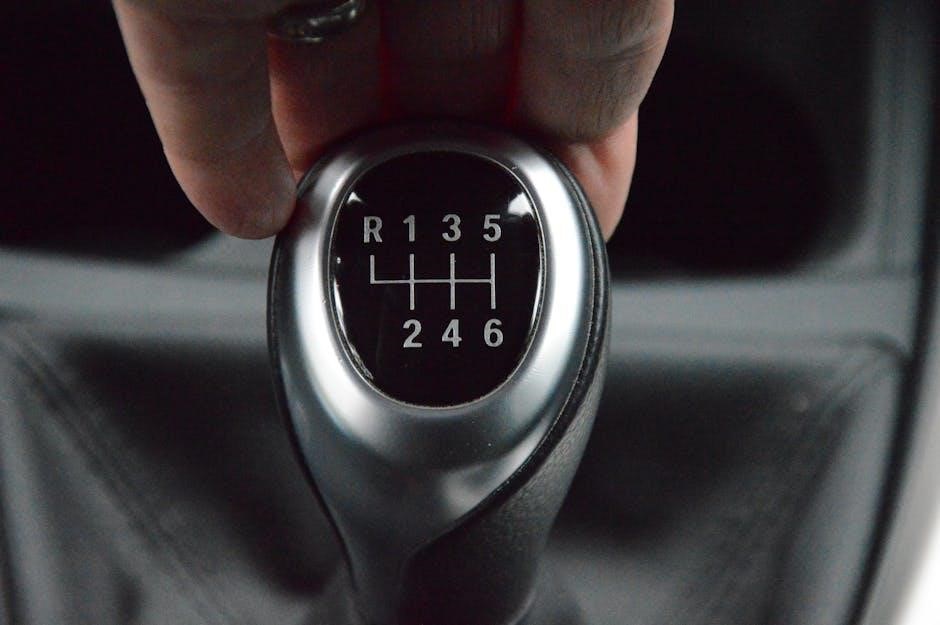
Automatic and manual cars differ primarily in how gears are shifted. Automatic cars change gears without driver input, while manual cars require driver operation via clutch and gearstick, offering distinct driving experiences based on preference and driving style.
Overview of Transmission Types
Transmission types determine how a car changes gears, with automatic and manual being the two primary systems. Automatic transmissions use a torque converter or continuously variable transmission (CVT) to shift gears automatically, eliminating the need for driver input. Manual transmissions require a clutch pedal and gearstick, allowing drivers to manually select gears. Each system offers unique advantages, catering to different driving preferences and conditions. Understanding these basics helps drivers choose the right transmission for their lifestyle and driving habits.
Importance of Understanding the Differences
Understanding the distinctions between automatic and manual cars is crucial for making informed decisions. It impacts factors like fuel efficiency, driving comfort, and cost. Manual transmissions often offer better control and lower expenses, while automatics provide ease, especially in urban settings. Knowing these differences helps drivers choose a car that aligns with their lifestyle, driving conditions, and personal preferences, ensuring a more satisfying and practical ownership experience tailored to their needs and habits.

Key Differences Between Automatic and Manual Cars
Automatic cars shift gears without driver input, while manual cars require clutch and gearstick operation, offering distinct driving experiences based on control, ease, and efficiency preferences.
Gear-Shifting Mechanism

In manual cars, drivers control gear shifts using a clutch pedal and gearstick, requiring coordination between accelerating and shifting. Automatic cars automatically change gears using a torque converter or CVT, eliminating the need for manual intervention, thus simplifying the driving process, especially in stop-and-go traffic, while manual transmissions provide more control over power delivery and fuel efficiency, appealing to drivers who prefer an engaged driving experience. This fundamental difference impacts both convenience and driver engagement.
Presence of Clutch Pedal
Manual cars feature a clutch pedal, essential for shifting gears, requiring drivers to press it down to engage or disengage the engine from the transmission. Automatic cars lack this pedal, streamlining the driving experience by eliminating the need for manual gear changes. The absence of the clutch in automatics reduces physical effort, making driving more accessible, especially in heavy traffic, while manuals require skill and coordination, enhancing driver involvement and control over acceleration and deceleration, appealing to those who enjoy a more hands-on driving experience.
Driver Involvement and Control
Manual cars require active driver engagement, as shifting gears and using the clutch demands attention and coordination. This creates a more hands-on driving experience, offering greater control over acceleration and deceleration. In contrast, automatic cars reduce driver involvement by handling gear shifts autonomously, minimizing the need for manual input. While manuals appeal to enthusiasts who enjoy precision and control, automatics provide a more relaxed, less demanding experience, particularly in urban or stop-start conditions, making them ideal for convenience-focused drivers seeking ease of use.

Pros of Manual Cars
Manual cars offer better fuel efficiency, cost-effectiveness, and an enhanced driving experience. They provide greater control over acceleration and braking, making them appealing to drivers who enjoy precision and engagement.
Better Fuel Efficiency
Manual cars generally offer better fuel efficiency compared to automatics, especially in city driving. The driver’s control over gear shifts allows for optimal engine performance, reducing fuel consumption. Modern manuals often have more gears, enhancing efficiency. However, driving style can impact this advantage, as aggressive acceleration may negate fuel savings. Overall, manuals tend to be more economical, making them a preferred choice for cost-conscious drivers seeking to minimize fuel costs.
Cost-Effectiveness
Manual cars are often more cost-effective than automatics, with lower purchase prices and maintenance costs. They typically have fewer complex components, reducing repair expenses. Additionally, insurance premiums for manual cars are sometimes lower due to their lower theft risk and simpler mechanics. This makes manual transmissions a budget-friendly choice for drivers seeking long-term savings without compromising performance.
Enhanced Driving Experience
Manual cars offer a more engaging and immersive driving experience by requiring active participation from the driver. The ability to control gear shifts provides a sense of connection to the vehicle, making driving feel more dynamic and enjoyable. This hands-on approach allows drivers to optimize acceleration and engine performance, especially in challenging road conditions, fostering a deeper appreciation for the art of driving and enhancing overall satisfaction behind the wheel.

Cons of Manual Cars

Manual cars have a steeper learning curve, require physical effort, and can be challenging in stop-start traffic, making them less convenient for urban or heavy-traffic driving conditions.
Steeper Learning Curve
Manual cars require mastering the coordination of clutch and gearstick, which can be challenging for new drivers. The complexity of manually shifting gears while managing speed and acceleration can feel overwhelming, especially in stop-start traffic. This difficulty deters many from learning to drive manual cars, as it demands practice and skill to operate smoothly. Additionally, the need to pass a practical test in a manual car to gain full driving privileges further highlights the steeper learning curve compared to automatic vehicles.
Increased Physical Effort
Driving a manual car requires constant engagement with the clutch pedal and gearstick, which can be physically demanding. Frequent use of the clutch in stop-start traffic or hilly terrain increases fatigue, especially for the left leg. Additionally, coordinating clutch presses with accelerator input and gear shifts demands more physical coordination and effort compared to automatic cars, where such actions are handled automatically, reducing driver strain during long drives or heavy traffic conditions.
Challenges in Stop-Start Traffic
Manual cars can be less convenient in stop-start traffic due to the need for frequent clutch and gear shifts. This constant engagement of the clutch pedal can be tiring and may lead to driver fatigue. Additionally, maintaining the correct gear and balance to avoid stalling requires more attention and effort in such conditions. In contrast, automatic cars handle these situations seamlessly, reducing the physical and mental strain on the driver in heavy traffic scenarios.

Pros of Automatic Cars
Automatic cars offer ease of use, reducing driver fatigue, and provide convenience in urban driving conditions. They eliminate the need for manual gear shifting, making them ideal for stop-and-go traffic.
Ease of Use
Automatic cars are incredibly user-friendly, requiring minimal driver input. With no clutch pedal or manual gear shifting, they simplify the driving process, especially in stop-and-go traffic. This eliminates the need for constant pedal coordination, reducing driver fatigue and stress. Automatics are perfect for urban environments, where frequent starts and stops are common. Their ease of operation makes them ideal for new drivers or those seeking a relaxed driving experience. This convenience is a significant advantage over manual transmissions;
Reduced Driver Fatigue
Automatic cars significantly reduce driver fatigue, especially in heavy traffic or long commutes. Without the constant need to press the clutch and shift gears, drivers can relax more, minimizing physical and mental strain. This makes automatics particularly beneficial for those who drive frequently in congested urban areas or on lengthy journeys. The elimination of manual shifting allows drivers to focus more on the road, enhancing overall comfort and reducing the risk of exhaustion during extended driving sessions.
Convenience in Urban Driving
Automatic cars offer unparalleled convenience in urban driving, where stop-start traffic is common. Without the need to constantly press the clutch or shift gears, drivers can navigate congested city roads with ease. This reduces physical effort and mental strain, making urban commuting less stressful. Automatics also simplify parking and low-speed maneuvers, allowing drivers to focus on the road without the hassle of manual gear changes. This convenience makes automatic cars a preferred choice for city driving, enhancing overall comfort and efficiency in urban environments.

Cons of Automatic Cars
Automatic cars often come with higher purchase and maintenance costs, reduced driver control over gear shifts, and potentially lower fuel efficiency compared to manual cars.
Higher Purchase and Maintenance Costs
Automatic cars generally have higher purchase prices compared to manual cars due to their complex transmission systems. Additionally, maintenance and repair costs for automatics tend to be more expensive, especially for components like torque converters or dual-clutch technologies; While modern automatics have improved significantly, their intricate design often leads to increased long-term ownership expenses. This financial burden can outweigh the convenience they offer, making manual cars a more cost-effective option for many drivers.
Less Control Over Gear Shifts
Automatic cars lack the driver’s direct control over gear shifts, as the transmission automatically selects gears based on speed and acceleration. While some modern automatics offer manual mode or paddle shifters, they still don’t provide the same level of precision as a manual gearbox. This can be a disadvantage in situations requiring precise control, such as uphill driving or towing, where manual gear selection is beneficial. The loss of driver input in gear changes reduces the connection between the driver and the vehicle’s performance.
Potential for Reduced Fuel Efficiency
Automatic cars historically have lower fuel efficiency compared to manual vehicles, especially in older models. Modern automatics with advanced gearboxes have narrowed this gap, but manuals still often retain a slight edge. The automatic’s torque converter and additional components can lead to increased fuel consumption, particularly in city driving or frequent stop-and-go traffic. However, driving habits and engine technology also play significant roles in determining actual fuel efficiency differences between automatic and manual cars.

Learning to Drive: Manual vs. Automatic
Learning to drive involves choosing between manual and automatic. Manuals require mastering the clutch and gearshift, offering more control, while automatics simplify the process but may limit driving privileges in some regions.
Should You Learn to Drive a Manual First?
Learning to drive a manual car first is often recommended as it provides a deeper understanding of vehicle mechanics and offers better control over the car. Manual cars are generally more cost-effective and fuel-efficient, making them a practical choice for many drivers. Additionally, having a manual license often increases resale value and allows drivers to operate both manual and automatic vehicles. However, if you exclusively plan to drive automatics, learning to drive a manual may not be necessary, depending on your lifestyle and preferences.
Impact on Licensing and Driving Privileges
Passing a driving test in a manual car allows drivers to operate both manual and automatic vehicles, offering greater flexibility. However, an automatic license restricts drivers to automatic cars only. Transitioning from an automatic to a manual license requires passing a second practical test. This distinction is crucial for drivers considering their long-term mobility and driving options.

Special Considerations for Choosing a Transmission Type
Selecting between automatic and manual transmissions involves evaluating driving habits, lifestyle, and future needs. Consider factors like commute conditions, personal preference, and long-term costs to make an informed decision.
Driving Conditions and Lifestyle
Your daily driving environment and personal lifestyle significantly influence the choice between automatic and manual cars. For frequent stop-start traffic, automatics reduce fatigue and effort. Manuals, however, offer better control on winding roads or in hilly areas. Consider whether your commute involves heavy traffic, long distances, or varied terrain. Additionally, lifestyle factors like enthusiast preferences or practical needs play a role. Balancing these aspects ensures the right transmission choice for optimal comfort and performance.
Future Resale Value
The choice between automatic and manual cars can impact future resale value.Automatics generally hold better value in urban areas due to higher demand for convenience, while manuals may appeal to driving enthusiasts. Regional preferences also play a role, as some markets favor manuals for sporty or classic vehicles. Additionally, the rising popularity of automatics in modern hybrids and electric cars may influence resale trends, making automatics more sought after in the long term.
The choice between automatic and manual cars depends on personal preference, lifestyle, and driving conditions. Both options offer unique advantages, making the decision subjective and based on individual needs.
Final Thoughts on Selecting the Right Transmission
Choosing between an automatic and manual transmission should align with your lifestyle, driving habits, and preferences. Manuals offer control and efficiency, ideal for enthusiasts and those in varied terrain. Automatics provide convenience and ease, perfect for urban commuting and reducing driver fatigue. Assess your needs, test drive both, and consider future resale value to make an informed decision tailored to your unique circumstances and priorities.
